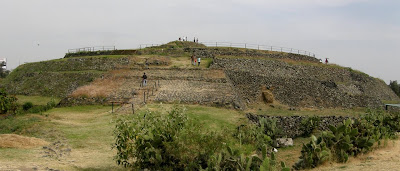 |
| View From The Balcony: Shades of Gray Cover the Countryside While Popo Puffs Away |
After a delightful visit to Chicago to play with our grandchildren, we arrived back in Mexico City on September 5th only to encounter more than a week of cloudy, cold and extremely wet days.
Last weekend, September 14, Mexico City found itself sandwiched between Hurricane Ingrid arriving from the Gulf to batter the coast of Veracruz; and Tropical Storm Manuel rolling in from the Pacific to wreak havoc along the Pacific Coast.
The silver lining is that on Monday the 15th after the storms, we were able to see the volcanoes for the first time in weeks. Thought you all might enjoy them in all their shades of gray highlighted by a touch of peach. Tomorrow's forecast: More heavy rain. Sigh....
I've written a lot about the impact of natural forces on Mexico's original peoples, but this week's storms have brought the topic home in a dramatic way. The juncture of multiple tectonic plates creates a volcanic axis that runs like a belt across Mexico's mid-section. It's hard to believe the number of both extinct and active volcanoes found along that axis. Mexico's geology also makes the country vulnerable to hurricanes that arrive both from the Pacific and Atlantic Oceans, although not usually at the same time!
This weekend's twin storms prompted us to reflect again on the cultural impact of the wind, including hurricanes, on Mexico's original peoples. When we began taking stock, we realized that the symbols are widely dispersed. Cuicuilco is one of the earliest settlements in the Valley of Mexico (Mexico City). Sometime between 150 and 200 Common Era, Cuicuilco was destroyed when Xitle, a nearby volcano, erupted. Cuicuilco's circular pyramid was dedicated to Ehécatl, god of wind.
This weekend's twin storms prompted us to reflect again on the cultural impact of the wind, including hurricanes, on Mexico's original peoples. When we began taking stock, we realized that the symbols are widely dispersed. Cuicuilco is one of the earliest settlements in the Valley of Mexico (Mexico City). Sometime between 150 and 200 Common Era, Cuicuilco was destroyed when Xitle, a nearby volcano, erupted. Cuicuilco's circular pyramid was dedicated to Ehécatl, god of wind.
 |
| Circular Pyramid at Cuicuilco, Mexico City, evokes the hurricane's swirling winds |
 |
| Cuicuilco's spiral retaining walls also served as the pyramid's staircase |
Also in Mexico City, but from the much later Aztec period, is the archaeological site at Tlatelolco, which has a temple to Ehécatl-Quetzalcóatl. Ehécatl is Quetzalcóatl's manifestation as the wind.
 |
| Temple to Ehécatl-Quetzalcóatl with remnants of its interior spiral |
On the back wall of the main pyramid at Tlatelolco is this symbol for Ehécatl-Quetzalcóatl; the spiral represents the hurricane's swirling winds.
 |
| Detail: Main Pyramid at Tlatelolco, Mexico City |
Next we go to the Templo Mayor (Great Temple) at Tenochtitlán [Historic District in Mexico City], where more representations of the spiral winds are to be found.
In Veracruz on the Gulf of Mexico, we have visited El Tajín (thunder, hurricane, lightning in the Totonaca dialect). The symbolism of hurricanes is visible in the greca escalonada, which archaeologists believe was originally in the form of a spiral (hurricane) before assuming its now-familiar geometric form.
 |
| Greca escalonada was probably a spiral before it took this geometric form. |
Also in Veracruz, we saw the tradition of the voladores (flyers), whose descending spiral 'dance' imitates the hurricane's spiral wind and, in so doing, evokes the form of the Ollin, or Life-Force.
 |
| Voladores (Flyers) from Papantla evoke the Ollín in the form of the swirling winds that form Hurricanes. |
The rains were key to the survival of the original peoples. In fact, an oft-quoted Mexico dicho (saying) is, "El agua es la vida" ("Water is life").
If anyone doubts the enduring strength of la naturaleza (natural forces) in Mexican culture, consider this: today I was chatting with a quite-modern Mexican friend. The conversation naturally shifted to the devastating floods and landslides attacking Mexico's people along both coastlines. She became quite animated, almost agitated, as she urgently insisted,
If anyone doubts the enduring strength of la naturaleza (natural forces) in Mexican culture, consider this: today I was chatting with a quite-modern Mexican friend. The conversation naturally shifted to the devastating floods and landslides attacking Mexico's people along both coastlines. She became quite animated, almost agitated, as she urgently insisted,
"It is the strength of la naturaleza; the Aztecs knew...."Postscript: After reading this post, a long-time geologist friend of mine wrote to give me this quote by Will Durant (1885-1981) American writer, historian, and philosopher:
"Civilization exists by geological consent, subject to change without notice."

your blog is very good, Greetings yes. also visit my blog Obat Kanker Darah | Obat Rematik
ReplyDelete